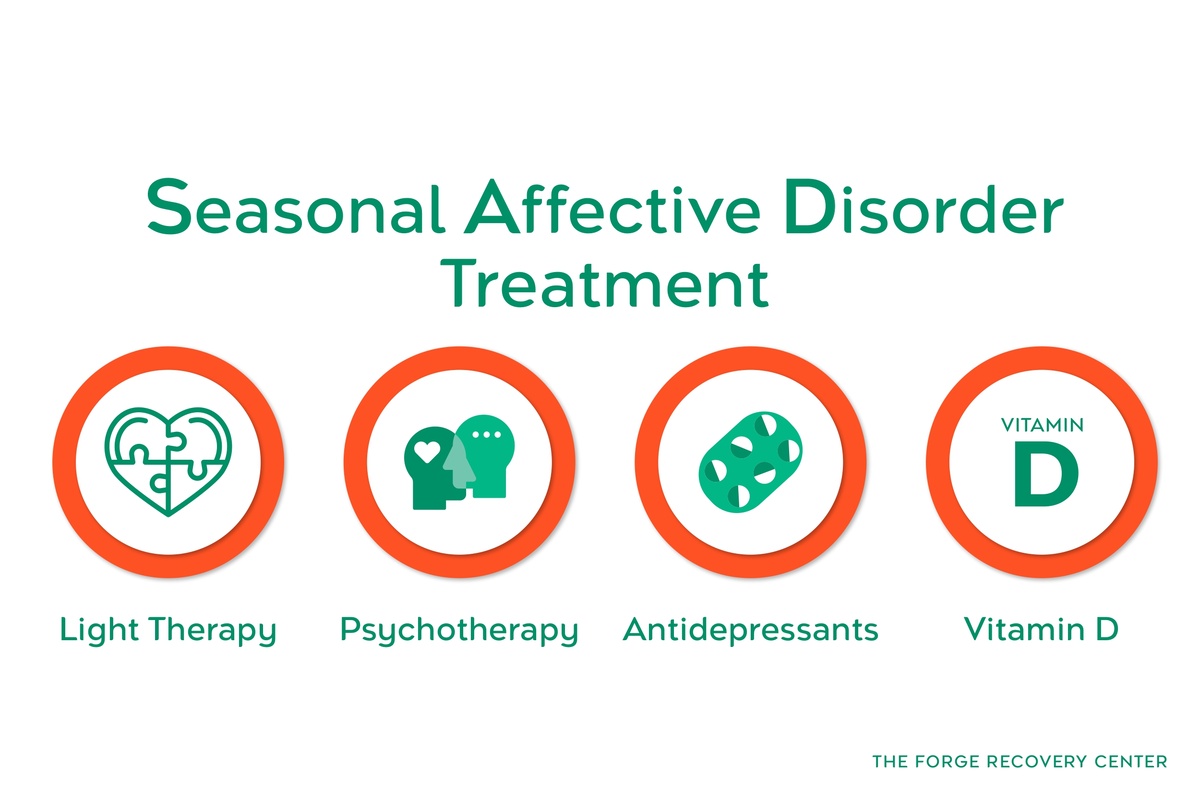Seasonal Affective Disorder: Symptoms, Causes, & How It’s Treated


Seasonal affective disorder (SAD) brings prolonged sadness and disinterest, especially during the darker fall and winter seasons, and we understand the weighty impact it can have on daily life. But treatment is available, typically in the form of light therapy, psychotherapy, and medication. Learn more about SAD symptoms and treatments, and contact The Forge Recovery Center if you or a loved one require a guide on your healing journey.
What Is Seasonal Affective Disorder?
Seasonal Affective Disorder (SAD) is a type of depression, a mood disorder, that occurs at a specific time of year, usually during the fall and winter months when there is less natural sunlight. Symptoms of SAD can include feelings of sadness, hopelessness, fatigue, changes in appetite, and difficulty concentrating.
It is believed that the lack of sunlight during these months can disrupt the body's internal clock and lead to hormonal imbalances that contribute to the development of SAD. Treatment for SAD may involve light therapy, counseling, medication, or a combination of these approaches to help manage symptoms and improve overall well-being.
Symptoms of Seasonal Affective Disorder
Symptoms typical of SAD include persistent feelings of sadness, difficulties sleeping, and general irritability, alongside certain emotional signals. Here’s an overview of symptoms associated with seasonal affective disorder:
Common Symptoms
When experiencing seasonal affective disorder, you might notice increased sleep, irritability, and a general feeling of sadness that persists. This condition typically manifests in two main forms: Fall-onset SAD, which begins in late fall and early winter, and Spring-onset SAD, starting in late spring or early summer. The hallmark of SAD is the recurrence of symptoms at the same times each year, coinciding with specific seasons.
Emotional Signs
Recognizing emotional signs of SAD is crucial for early intervention. You may notice social withdrawal, a loss of interest in activities once enjoyed, and feelings of hopelessness. Emotional indicators such as fatigue and decreased sex drive can signal the presence of SAD. Being aware of these emotional cues can aid in prompt diagnosis and treatment to alleviate symptoms effectively.

Are You Struggling with Mental Health or Addiction?
We Can Help. Call Us Now!
CALL: 877-839-1772
Seasonal Affective Disorder Treatment
Seasonal affective disorder is often treated with light therapy, psychotherapy, and antidepressant medications. It’s also important to recognize the role of natural sunlight and vitamin D in naturally increasing serotonin levels in the brain. Here’s a quick overview of treatment options for SAD, which are typically administered by a mental health professional or at a mental health treatment center:
Light Therapy
When treating SAD, light therapy is a common approach. Exposure to bright light helps regulate your body's internal clock and improve mood. This therapy involves sitting near a lightbox that emits 10,000 lux of light.
In managing SAD symptoms, getting natural sunlight is crucial. Sunlight exposure boosts the production of serotonin, a neurotransmitter linked to mood regulation. The most common lights used in therapy are full-spectrum lights and dawn simulators.
Psychotherapy
For those with SAD, psychotherapy can be beneficial. This treatment focuses on addressing your emotional well-being and coping strategies. Psychotherapy such as CBT or DBT can offer a safe space to explore and manage your feelings during the dark seasons.
Psychotherapy plays a vital role in helping you cope with SAD by providing tools to navigate feelings of isolation and sadness. By working with a therapist, you can develop skills to combat negative thought patterns.
Antidepressants
In some cases, healthcare professionals may prescribe antidepressants for SAD treatment. These medications help regulate neurotransmitters like serotonin and norepinephrine, improving mood stability. It's important to consult a doctor before starting antidepressant therapy.
Antidepressants play a key role in managing SAD symptoms by alleviating feelings of sadness and hopelessness. They can help restore chemical imbalances in the brain associated with seasonal depression.
Vitamin D
Vitamin D is essential for managing SAD as it influences serotonin levels in the brain. Low levels of Vitamin D are linked to an increased risk of depression during darker months. Sources of Vitamin D include sunlight exposure, fatty fish, fortified dairy products, and supplements.
Ensuring adequate Vitamin D levels through diet or supplements can support your mental well-being during periods of reduced sunlight exposure. Incorporating Vitamin D-rich foods into your diet can complement other treatments for SAD effectively.

Light Therapy, Explained
Light therapy is a unique modality designed to mimic natural sunlight, which can help to regulate your body’s internal clock and serotonin levels. Here’s how it works:
How It Works
When dealing with seasonal affective disorder, it's crucial to understand the biological processes at play. SAD is linked to changes in your body's internal clock, influenced by the amount of daylight you receive. This condition disrupts your circadian rhythm and affects the production of melatonin, a hormone that regulates sleep.
To combat SAD, light therapy mimics natural sunlight to regulate your body's internal clock. By exposing yourself to bright light, especially in the morning, you can effectively manage symptoms of SAD. The light from therapy boxes helps reduce the overproduction of melatonin associated with this disorder.
Understanding how SAD works is key to finding relief through light therapy. By acknowledging its impact on your circadian rhythm and melatonin levels, you can take proactive steps toward managing this seasonal condition effectively.
Types of Lights
In light therapy for SAD, various types of lights are utilized to alleviate symptoms during darker seasons. Bright light therapy involves exposure to high-intensity lamps that mimic natural sunlight. These lamps emit around 10,000 lux of light intensity.
On the other hand, dawn simulators provide a gentler approach by gradually increasing light intensity, simulating a sunrise in your room. This gradual transition from darkness to light helps regulate your body's wake-up process naturally.
Each type of light therapy has its benefits; bright light therapy is known for immediate results in boosting mood and energy levels, while dawn simulators offer a more gradual awakening experience. Depending on your preference and symptom severity, you can choose the type of light therapy that suits you best.
Are You Struggling with Mental Health or Addiction?
We Can Help. Call Us Now!
CALL: 877-839-1772
Psychotherapy for SAD
Psychotherapy is also a common treatment for seasonal affective disorder, specifically cognitive-behavioral therapy (CBT). Along with therapy, having a solid emotional support system can make a significant difference in your well-being when depressive feelings strike. Let’s explore the role of psychotherapy for SAD in more detail:
Cognitive Behavioral Therapy (CBT)
CBT focuses on changing negative thought patterns that contribute to SAD. By challenging these thoughts, you can shift to a more positive mindset. This therapy also helps improve coping strategies, equipping you with tools to navigate the challenges of SAD more effectively. With CBT, you learn how to manage stress and anxiety better. The benefits of CBT extend to the long-term management of SAD symptoms. By addressing underlying issues, you can experience lasting relief from the effects of seasonal changes.
Emotional Support
Emotional support plays a crucial role in managing Seasonal Affective Disorder. Having a strong support system can significantly impact your well-being during difficult times. Friends and family members are essential sources of emotional support for individuals dealing with SAD. Their understanding and encouragement can uplift you when feeling low. Support groups and counseling offer additional avenues for seeking emotional support. Connecting with others who share similar experiences can provide comfort and validation for your struggles.

What Causes Seasonal Affective Disorder?
Seasonal affective disorder is primarily caused by seasonal changes that disrupt your circadian rhythm, impacting your sleep patterns and overall mood. These effects are linked to reduced sunlight exposure, which in turn can adversely affect your brain chemistry. Genetic predispositions and certain environmental factors can also play a role. Here’s an overview of the main drivers of SAD:
Biological Causes
When it comes to seasonal changes, various biological factors contribute to the development of SAD. Your body's internal clock, known as the circadian rhythm, gets disrupted during darker months, affecting your sleep patterns and mood. This disruption is linked to the reduced exposure to sunlight, which can impact your brain chemistry.
Melatonin and serotonin play crucial roles in SAD. Melatonin, a hormone that regulates sleep-wake cycles, tends to increase with darkness, leading to symptoms like fatigue and lethargy. On the other hand, serotonin, a neurotransmitter responsible for mood regulation, decreases due to reduced sunlight exposure during winter months, contributing to feelings of depression and sadness.
Genetic predispositions also play a significant role in SAD. If you have a family history of depression or bipolar disorder, you may be more susceptible to developing SAD. Variations in brain chemistry involving neurotransmitters like dopamine and norepinephrine can influence your vulnerability to seasonal mood changes.
Environmental Factors
Environmental factors can exacerbate symptoms of SAD. The lack of sunlight during winter months can disrupt your body's internal clock and lead to imbalances in hormones like melatonin and serotonin. Living in regions with prolonged periods of darkness or cloudy weather can intensify these effects, making you more prone to experiencing SAD symptoms.
The impact of weather and geographical location is significant in understanding SAD. For example, individuals living in northern latitudes where daylight hours are shorter during winter are at higher risk of developing SAD compared to those closer to the equator. Exposure to natural light plays a crucial role in regulating your mood and energy levels.
To mitigate the effects of environmental factors on SAD, incorporating lifestyle changes can be beneficial. Engaging in regular physical activity outdoors during daylight hours can help improve your mood by increasing exposure to natural light. Creating a daily routine that includes time spent outdoors or near windows can also enhance your overall well-being during darker months.
Are You Struggling with Mental Health or Addiction?
We Can Help. Call Us Now!
CALL: 877-839-1772
Effects of SAD on Daily Life
The depressive and irritable feelings brought on by seasonal affective disorder can impact many aspects of life, particularly your relationships and work performance:
Relationships
Living with SAD can strain your relationships due to mood changes and lack of energy. Your partner may feel confused or distant when you experience SAD symptoms. To improve communication, express your feelings openly and educate your partner about SAD. Seeking couples therapy can help navigate relationship challenges caused by SAD.
Career
Dealing with SAD can impact your career by affecting productivity and motivation levels. You might find it challenging to focus at work during SAD episodes. To manage work responsibilities, prioritize tasks during periods of higher energy and seek support from colleagues. Workplace accommodations such as flexible hours or natural light exposure can assist individuals with SAD in maintaining their job performance.
Diagnosing Seasonal Affective Disorder
When diagnosing seasonal affective disorder, healthcare providers and mental health treatment experts will look at your medical history, before moving onto physical and psychological exams. Here’s how the diagnostic process works:
Medical History
When diagnosing seasonal affective disorder, your medical history plays a crucial role. Providing a detailed account of your past medical conditions can help healthcare professionals understand how these factors may contribute to the development of SAD. By sharing information about your health history, you enable professionals to make accurate assessments and tailor treatment plans to your specific needs.
A comprehensive medical history allows healthcare providers to identify any underlying health issues that could be exacerbating symptoms of SAD. By understanding your medical background, professionals can gain insights into potential risk factors and develop targeted interventions. Therefore, it is essential to be thorough and open when discussing your past medical experiences with your healthcare team.
Physical Exam
When suspected of having SAD, undergoing a physical exam is an essential step in the diagnostic process. This examination involves assessing various aspects of your physical health to rule out other conditions that may mimic symptoms of SAD. Through this evaluation, healthcare providers can gather valuable information about your overall well-being and identify any potential physical contributors to your symptoms.
A thorough physical exam allows healthcare professionals to detect any signs or symptoms that may indicate underlying health issues. By examining factors such as vital signs, appearance, and physical functioning, practitioners can gain a comprehensive understanding of your health status. Therefore, undergoing a physical exam is vital in ensuring an accurate diagnosis and appropriate treatment for SAD.
Psychological Evaluation
In diagnosing SAD, a psychological evaluation is conducted by mental health professionals to assess your mental well-being comprehensively. This evaluation involves exploring aspects such as mood patterns, behavioral tendencies, and emotional responses to different situations. By delving into these psychological aspects, experts can gain insights into the nature and severity of your symptoms.
Mental health professionals play a significant role in conducting psychological evaluations for individuals with suspected SAD. Through these assessments, they can identify specific mental health challenges you may be facing and develop tailored treatment strategies accordingly. Providing accurate information during a psychological evaluation is crucial for obtaining an accurate diagnosis and receiving appropriate support for managing SAD.

Are You Struggling with Mental Health or Addiction?
We Can Help. Call Us Now!
CALL: 877-839-1772
SAD Prevalence Rates
According to recent statistics, about 5% of U.S. adults experience SAD, which can last up to 40% of the year. Prevalence changes when underlying mental health conditions are present, however, with SAD affecting between 10% and 20% of people with major depressive disorder and about 25% of people with bipolar disorder.
Age & Location
Different age groups experience varying prevalence rates of seasonal affective disorder. Adults, particularly those between 18 and 30 years old, are at a higher risk of developing SAD compared to younger individuals.
In this age bracket, the stressors of adult life, such as work responsibilities and financial pressures, can exacerbate the symptoms of SAD. The lack of coping mechanisms in young adults may also contribute to the increased prevalence rates within this age group.
Certain areas that receive less sunlight may also pose higher rates of SAD. According to the Mayo Clinic, SAD is more common among people living far north or south of the equator, likely due to the decreased sunlight during the winter and longer days during the summer.
Gender Disparities
Gender differences also play a significant role in the prevalence rates of seasonal affective disorder, with women being more affected than men. This discrepancy is thought to be linked to hormonal fluctuations that occur during the menstrual cycle, pregnancy, and menopause.
The hormonal changes experienced by women can influence neurotransmitters like serotonin and melatonin, which are crucial in regulating mood and sleep patterns. These fluctuations can make women more susceptible to developing SAD compared to men.
Closing Thoughts
Now that you understand seasonal affective disorder (SAD) better, recognizing its symptoms, treatment options like light therapy and psychotherapy, its causes, effects on daily life, prevalence rates, and how it's diagnosed, you can take proactive steps to manage SAD effectively. Remember to prioritize self-care, seek professional help if needed, and make use of available resources to combat the challenges posed by SAD. By staying informed and proactive, you can navigate through the difficulties that SAD brings and lead a fulfilling life even during the darker months.
Don't let SAD control your well-being. Take charge of your mental health by implementing the strategies discussed in this article. Your mental health matters, and addressing SAD is a crucial step towards maintaining a balanced and healthy lifestyle. Stay informed, seek support when needed, and remember that you are not alone in this journey towards better mental well-being.
Seasonal Affective Disorder Treatment in Orange County
Seasonal affective disorder causes heavy feelings of sadness during darker months that can confine you to bed, dim the joy in activities you once loved, and strain precious connections. Thankfully, help is available — and we’d love to offer our support.
The Forge Recovery Center offers a team of mental health experts and a set of proven therapies to guide you toward a place of mental peace. If you or a loved one are feeling weighed down by SAD and require professional support, contact us today to start healing. A clearer, lighter mind is just a phone call away.



